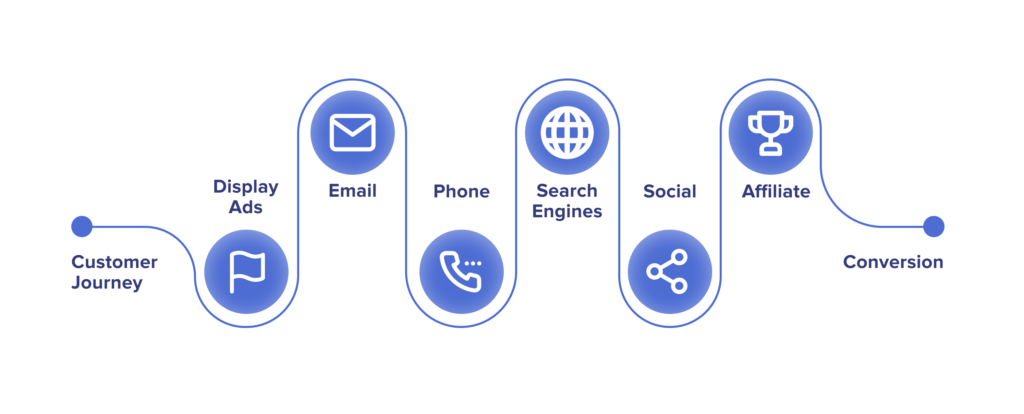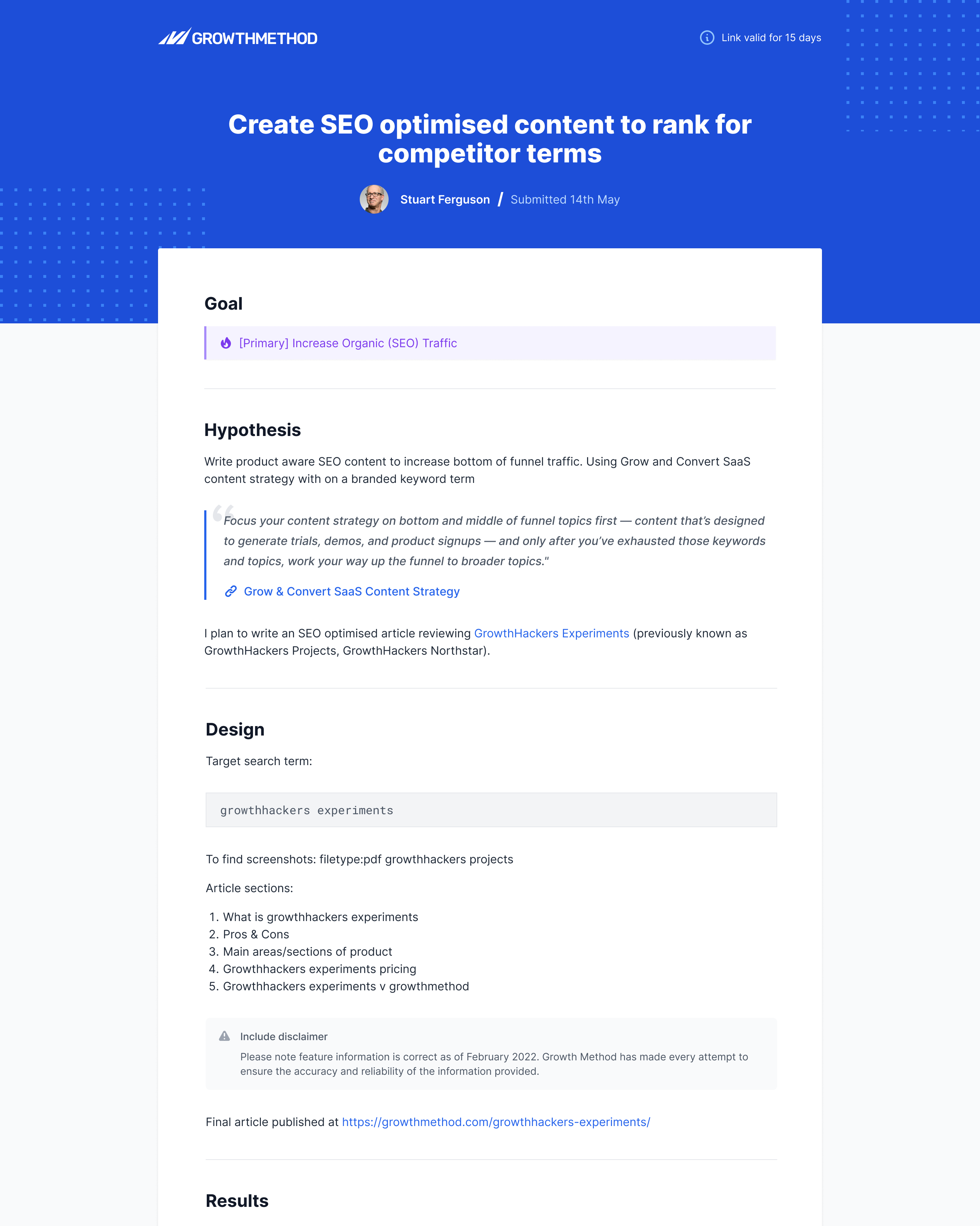Everything you need to know about GA4 data-driven attribution
Article originally published in January 2024 by Stuart Brameld. Most recent update in April 2024.
Request a demo
Project management for growth and agile marketing professionals. Map your acquisition funnel, integrate analytics and run agile experiments.
Experiment results
Recent experiments results include competitor SEO, AI-driven content, exit-intent modals and AB testing homepage headlines.
Case study
"We are on-track to deliver a 43% increase in inbound leads this year. There is no doubt the adoption of Growth Method is the primary driver behind these results."
![]()
Certified
We are vetted mentors with Growth Mentor and a partner with the Agile Marketing Alliance.
What is attribution?
Attribution models (like Google Analytics data-driven attribution) help you accurately credit actions that lead to a conversion or sale.
“Attribution is the act of assigning credit for conversions to different ads, clicks, and factors along a user’s path to completing a conversion. An attribution model can be a rule, a set of rules, or a data-driven algorithm that determines how credit for conversions is assigned to touchpoints on conversion paths.”
https://support.google.com/analytics/answer/10596866
Why use attribution?
Attribution helps businesses understand which marketing channels and touch points are most effective in driving conversions and sales.

Attribution helps in understanding:
- The effectiveness of different marketing channels
- Which touch points in the customer journey are most frequently used by customers
- Which touch points in the customer journey have the most impact on conversions
- Marketing campaign performance and optimisation opportunities
This information can be used to improve the customer experience, as well as to inform marketing strategy and budget allocation.
Rules-based attribution models
Rule-based (or heuristic) attribution models use rules to assign credit to touch points based on their position in the customer journey.

Here is a list of the most common rules-based attribution models.
| Model | Type | Details |
|---|---|---|
| First touch | Single touch | All credit for the conversion is given to the first interaction. If a user only has a single interaction (or all interactions come from the same medium) then first-touch and last-touch will show identical values. The first-touch model is often used for measuring awareness focused “top of funnel” activity (i.e. what brought users to the site). |
| Last touch | Single touch | All credit for the conversion is given to the last interaction. The last (non-direct) interaction has historically been the default in Universal Analytics (GA3) and still exists today as an option in GA4. |
| Linear | Multi touch | The linear attribution model treats all the touchpoints in the conversion path equally. If there are 5 interactions leading up to a conversion, each interaction would take 1/5th (or 20%) of the credit. |
| Time Decay | Multi touch | With the time decay model, most recent interactions are given more credit. This model is based on the theory that older interactions and less relevant to the conversion that more recent interactions. Time decay models use a half-life (or decay rate). For example, a 7-day half-life means a conversion that occurred 7 days ago would receive half the credit of an interaction that occurred on the same day as the conversion. |
| Position Based | Multi touch | Position-based attribution typically aims to give credit to the first and last touchpoints in the conversion path. Typically a position-based model would credit 40% on the conversion credit to the first (discovery) interaction, and 40% to the last (conversion) interaction, with the remaining 20% divided equally between the remaining interactions. |
Algorithmic attribution models
Algorithmic (or data-driven) attribution models rely on mathematical algorithms, machine learning and historical data to analyse customer data and assign credit based on the impact of each touchpoint on the conversion.
Unlike rule-based models, there are no predetermined formulas used in data-driven models. Instead, algorithmic models use your unique historical data combined with an algorithmic estimation of the significance of that touchpoint in converting the customer.
| Model | Type | Details |
|---|---|---|
| Shapley Value | Multi touch | Shapley Value attribution is uses game theory to consider the contribution of all channels involved in a conversion. See this article for more information. |
| Markov Chains | Multi touch | Markov chains is an attribution model derived from probability theory in order to understand the effectiveness of different marketing channels in a customer’s journey. Markov Chains view the customer journey as a series of transitions between different states (ad view, link click, web visit etc) and assign a probability to each transition, indicating the likelihood of moving from one touchpoint to another. See this article for more information. |
| GA4 DDA | Multitouch | Data-driven attribution (DDA) in GA4 is based on the Shapley model above, with an added time decay element, where interactions that happen more recently are valued more than actions that happened a long time ago. |
What is data-driven attribution?
Despite what many marketers think, Google’s data-driven attribution (DDA) model has been around for some time.
- In 2013 Google first introduced data-driven attribution to Google Analytics 360 (the premium enterprise version of Google Analytics)
- In 2016 DDA was introduced to the Google AdWords platform
- In 2020 data-driven attribution was made available for all Google Analytics customers with the release of GA4
- In 2023, Google removed first-click, linear, time-decay, and position-based attribution models, leaving just data-driven and last click models available, and made DDA the default and preferred option
Data-driven attribution distributes credit for the conversion based on data for each conversion event. It’s different from the other models because it uses your account’s data to calculate the actual contribution of each click interaction.
https://support.google.com/analytics/answer/10596866
How does data-driven attribution work?
Data-driven attribution in GA4 works by learning how different touch points impact conversion outcomes over time. GA4 analyses historical data, identifies correlations and trends between key data points, and uses those insights to make predictions about the customer journey.

Without diving into mathematics and statistics, here are some of the core concepts in GA4’s data-driven attribution.
- When calculating conversion credit data-driven attribution (DDA) in GA4 takes the last 50 interactions into consideration (the data-driven attribution model in Universal Analytics only considered the previous 4 interactions)
- GA4 has a 90-day lookback window for all conversion events by default (this can be changed to 30 or 60 days if desired)
- By default, conversion modelling is used to fill in gaps in your data as a result of cookie restrictions and cross-device behaviour, see https://support.google.com/analytics/answer/10710245 for more information.
- Time-to-event considers the relative time to conversion a touchpoint has when assigning credit. In practise this means conversions occurring soon after a touchpoint are more likely to have been caused by the interaction, and therefore receive more credit.
For more detailed information on GA4 DDA we recommend the articles below:
- [GA4] About attribution and attribution modeling, from the Google team
- An Overview of Data-Driven Attribution in GA4 from the Cardinal Path team
- [GA4] Behavioral modeling for consent mode from the Google team
Advantages of using GA4 data-driven attribution
On the whole GA4 DDA is a fairer, more complete attribution model, particularly for B2B companies that have longer more complex buying journeys as it allows a single conversion event to be associated with multiple touchpoints and traffic sources.
“Google’s data-driven attribution models give you a better understanding of how all of your marketing activities collectively influence your conversions, so you don’t over or undervalue a single channel. Unlike last-click attribution, where 100% of the credit goes to the final interaction, data-driven attribution distributes credit to each marketing touchpoint based on how much impact the touchpoint had on driving a conversion.”
https://blog.google/products/marketingplatform/analytics/meet-marketing-objectives-with-new-google-analytics/
Unlike last-click attribution in Universal Analytics, DDA provides a more holistic view of your conversion paths, and is able to do so in a modern post-cookie and privacy-first world. Even if the last click from a channel doesn’t result in a conversion, the interaction will still result in some credit being given to that channel enabling better understanding of how higher-funnel touchpoints lead to down-funnel conversions.
GA4 is also well-suited to serve as the single source of attribution truth across all Google’s media platforms. Whilst Google Ads, Search Ads 360 and Display & Video 360 all offer DDA, GA4 is designed to be the largest, most informed and most accurate DDA model available for cross-channel, cross-platform, multi-touch attribution.

Limitations of using GA4 data-driven attribution
The biggest downside, or culture change when moving to data-driven attribution, is that DDA is somewhat of a black box. There is a lack of transparency compared with the older first-click and last-click models. With DDA you provide Google with the inputs (the interactions from your marketing efforts), Google’s machine learning performs data modelling behind the scenes, and the output is your conversions attributed to various channels.
Some other limitations and details you should be aware of:
- All models are only as good as the data they are provided, inaccuracies in tracking can lead to incorrect attributions
- All attribution models still largely fail to account for offline-to-online effects and are unable to account for contributions such as word of mouth, brand equity and other external factors
- You cannot adjust Google’s channel groupings (though you can create custom channel groups)
- Attribution values calculated by Google are only available within the interface and not exported to BigQuery
- With low conversion volumes you may see DDA conversion credits resemble last-click attribution
- Attribution data can still be updated for up to 9 days after a recorded conversion (see below)
“When looking at Google Analytics reports, keep in mind that attributed conversion data for each channel can still be updated for up to 9 days after the conversion is recorded. For increased accuracy, select a date range beyond or prior to the previous week.”
https://support.google.com/analytics/answer/10710245
Note: GA4 has 3 source dimensions – First User Source, Session Source and Source. Always use Source as this is a source that received at least partial credit for a conversion based on your default attribution model.
Final thoughts
“All models are wrong, but some are useful.”
George Box, Statistician
Whilst no attribution model is perfect, GA4 DDA is arguably Google’s best attribution model available to date. It is particularly well-suited to more complex and longer B2B buying journeys, and aims to solve many of the challenges to marketing analytics and attribution in a post-cookie and privacy-first world.


